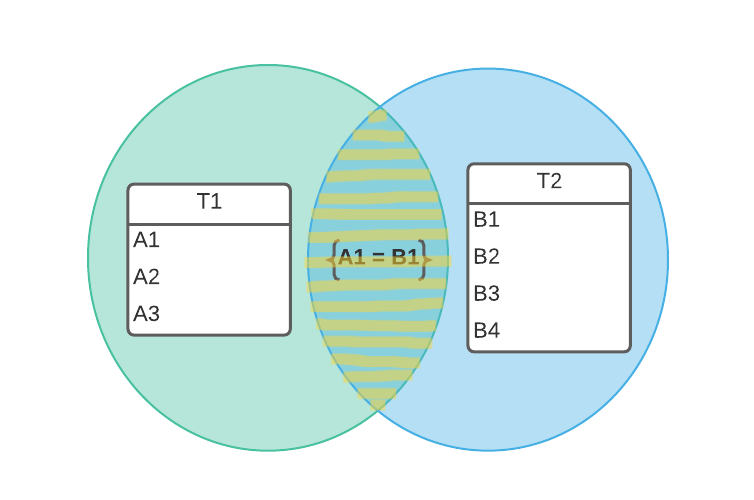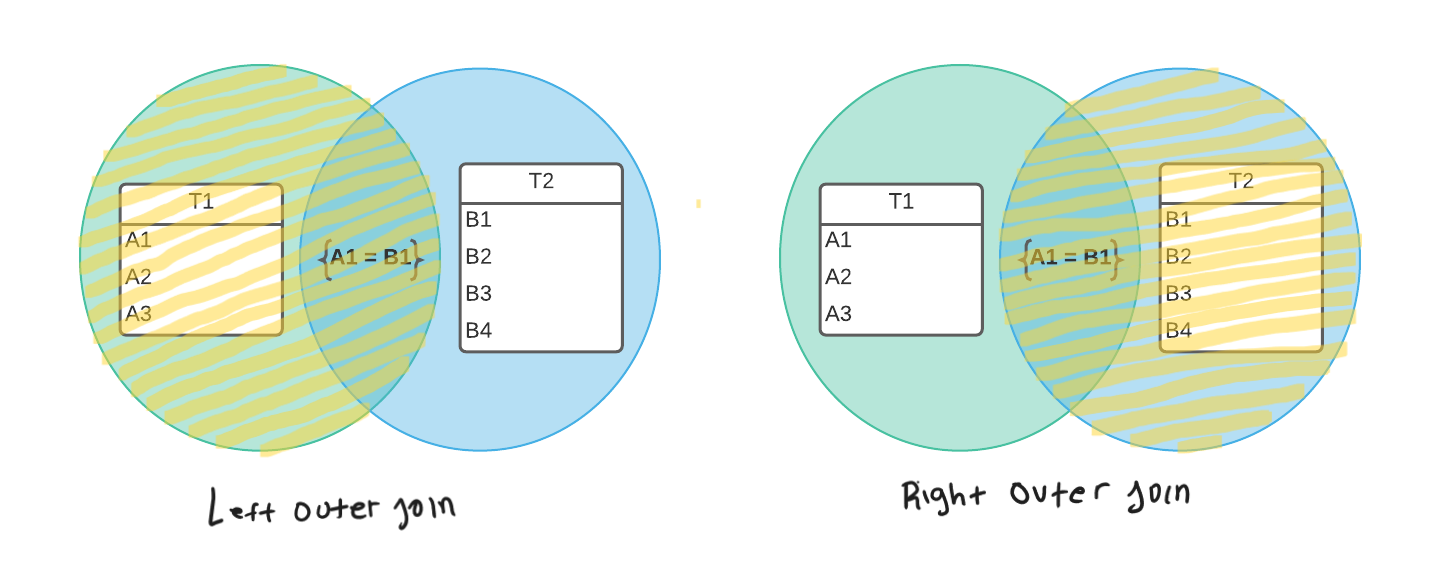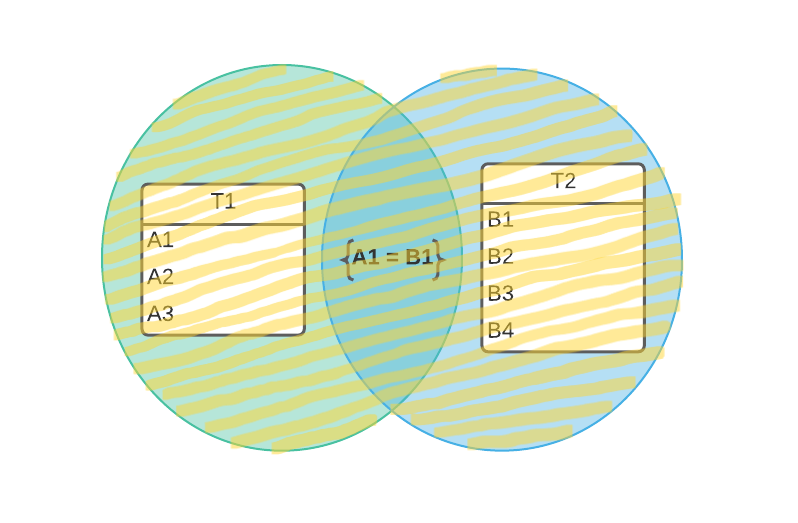Joined Tables
Hai semuanya, di materi kali ini kita akan membahas Join Tables di PostgreSQL, Seperti biasa materinya karena akan lumayan panjang jadi kita bagi menjadi beberapa section ya diantaranya:
- What is join tables?
- Natural Join
- Cross join
- Qualified join
- Inner Joins
- Left or Right Outer Joins
- Full Outer Joins
- Self Joins
join_conditionexpressions
Ok langsung aja yuk kita bahas materi yang pertama:
What is join tables?
A joined table is a table derived from two other (real or derived) tables according to the rules of the particular join type. Inner, outer, and cross-joins are available.
The general syntax of a joined table is
SELECT select_list_expression
FROM T1 join_type T2 [ join_condition ]Joins of all types can be chained together, or nested: either or both T1 and T2 can be joined tables.
For example if you have table design look like above, join query:
SELECT *
FROM employees natural join jobs;Natural Join
A natural join is a join that creates an implicit join based on the same column names in the joined tables.
The general syntax of a natural joined table is
SELECT select_list_expression
FROM T1 NATURAL [INNER, LEFT, RIGHT] T2;Join statement can be more than once, and Parentheses can be used around JOIN clauses to control the join order. In the absence of parentheses, JOIN clauses nest left-to-right.
Jika dijalankan maka hasilnya seperti berikut:
hr=# SELECT emp.job_id, job.job_title, emp.employee_id, emp.first_name, loc.street_address
hr-# FROM employees emp
hr-# natural join jobs job
hr-# natural join locations loc
hr-# limit 10;
job_id | job_title | employee_id | first_name | street_address
------------+-------------------------------+-------------+------------+----------------------
AD_PRES | President | 100 | Steven | 1297 Via Cola di Rie
AD_VP | Administration Vice President | 101 | Neena | 1297 Via Cola di Rie
AD_VP | Administration Vice President | 102 | Lex | 1297 Via Cola di Rie
IT_PROG | Programmer | 103 | Alexander | 1297 Via Cola di Rie
IT_PROG | Programmer | 104 | Bruce | 1297 Via Cola di Rie
IT_PROG | Programmer | 105 | David | 1297 Via Cola di Rie
IT_PROG | Programmer | 106 | Valli | 1297 Via Cola di Rie
IT_PROG | Programmer | 107 | Diana | 1297 Via Cola di Rie
FI_MGR | Finance Manager | 108 | Nancy | 1297 Via Cola di Rie
FI_ACCOUNT | Accountant | 109 | Daniel | 1297 Via Cola di Rie
(10 rows)
If you use the asterisk (*) in the select_list, the result will contain the following columns:
- All the common columns, which are the columns from both tables that have the same name.
- Every column from both tables, which is not a common column.
However, you should avoid using the NATURAL JOIN whenever possible because sometimes it may cause an unexpected result.
For example, See the following customers and transactions tables from the sample database:
Both tables have the same cust_id column so you can use the NATURAL JOIN to join these tables as follows:
SELECT *
FROM customers NATURAL JOIN transactions;But both tables also have another common column called last_update, which cannot be used for the join (ambiguous).
Cross join
Cross join is For every possible combination of rows from T1 and T2 (i.e., a Cartesian product), the joined table will contain a row consisting of all columns in T1 followed by all columns in T2. If the tables have N and M rows respectively, the joined table will have N * M rows.
FROM T1 CROSS JOIN T2 is equivalent to FROM T1 INNER JOIN T2 ON TRUE
For example:
Jika di jalankan maka hasilnya seperti berikut:
hr=# select count(*) from departments;
count
-------
28
(1 row)
hr=# select count(*) from jobs;
count
-------
19
(1 row)
hr=# SELECT dep.department_id, dep.department_name, job.job_id, job.job_title
hr-# FROM departments dep
hr-# CROSS JOIN jobs job;
department_id | department_name | job_id | job_title
---------------+----------------------+------------+---------------------------------
300 | System Analis | AD_PRES | President
300 | System Analis | AD_VP | Administration Vice President
300 | System Analis | AD_ASST | Administration Assistant
300 | System Analis | FI_MGR | Finance Manager
300 | System Analis | FI_ACCOUNT | Accountant
300 | System Analis | IT_PROG | Programmer
300 | System Analis | MK_MAN | Marketing Manager
300 | System Analis | MK_REP | Marketing Representative
300 | System Analis | HR_REP | Human Resources Representative
300 | System Analis | PR_REP | Public Relations Representative
10 | Administration | AD_PRES | President
10 | Administration | AD_VP | Administration Vice President
10 | Administration | AD_ASST | Administration Assistant
10 | Administration | FI_MGR | Finance Manager
10 | Administration | FI_ACCOUNT | Accountant
10 | Administration | AC_MGR | Accounting Manager
10 | Administration | AC_ACCOUNT | Public Accountant
10 | Administration | SA_MAN | Sales Manager
(532 rows)
hr=# select count(*) from departments cross join jobs;
count
-------
532
(1 row)
Qualified Join
Qualified Join ini adalah sesuai artinya join yang memiliki criteria atau condition (join_condition) tertentu.
Basicly the join_condition is specified in the ON or USING or WHERE clause, or implicitly by the word NATURAL. The join condition determines which rows from the two source tables are considered to “match”, as explained in detail below.
Qualified join terdiri dari
INNER JOIN. For each rowR1ofT1, the joined table has a row for each row inT2that satisfies the join condition withR1.LEFT OUTER JOIN. First, an inner join is performed. Then, for each row inT1that does not satisfy the join condition with any row inT2, a joined row is added withnullvalues in columns ofT2. Thus, the joined table always has at least one row for each row inT1.RIGHT OUTER JOIN. First, an inner join is performed. Then, for each row inT2that does not satisfy the join condition with any row inT1, a joined row is added withnullvalues in columns ofT1. This is the converse of a left join: the result table will always have a row for each row inT2.FULL OUTER JOIN. First, an inner join is performed. Then, for each row inT1that does not satisfy the join condition with any row inT2, a joined row is added withnullvalues in columns ofT2. Also, for each row ofT2that does not satisfy the join condition with any row inT1, a joined row with null values in the columns ofT1is added.
The general syntax of a qualifier join table is
T1 { [INNER] | { LEFT | RIGHT | FULL } [OUTER] } JOIN T2 ON boolean_expression
T1 { [INNER] | { LEFT | RIGHT | FULL } [OUTER] } JOIN T2 USING ( join column list )
T1 NATURAL { [INNER] | { LEFT | RIGHT | FULL } [OUTER] } JOIN T2Qualified using INNER JOIN
Inner Join adalah Join table yang paling commons di gunakan untuk menggabungkan antara ke 2 tabel atau lebih. Secara konsep matematika INNER JOIN akan menggunakan condition yang jika T1 dan T2 bernilai sama seperti ilustrasi berikut:

Contohnya saya punya perancangan table seperti berikut
Maka querynya seperti berikut:
Atau jiga kita bisa menggunakan lebih specify yaitu INNER JOIN seperti berikut:
Jika dijalankan maka hasilnya seperti berikut:
hr=# SELECT emp.employee_id, emp.last_name, job.job_id, job.job_title
hr-# FROM employees emp
hr-# inner join jobs job on (emp.job_id = job.job_id)
hr-# LIMIT 10;
employee_id | last_name | job_id | job_title
-------------+-----------+------------+-------------------------------
100 | King | AD_PRES | President
101 | Kochhar | AD_VP | Administration Vice President
102 | De Haan | AD_VP | Administration Vice President
103 | Hunold | IT_PROG | Programmer
104 | Ernst | IT_PROG | Programmer
105 | Austin | IT_PROG | Programmer
106 | Pataballa | IT_PROG | Programmer
107 | Lorentz | IT_PROG | Programmer
108 | Greenberg | FI_MGR | Finance Manager
109 | Faviet | FI_ACCOUNT | Accountant
(10 rows)
Qualified using Left or Right OUTER JOIN
Selain INNER JOIN terdapat OUTER JOIN. OUTER JOIN terdiri dari 2 kombinasi yaitu
LEFT OUTER JOINRIGHT OUTER JOIN
Secara konsep matematika OUTER JOIN jika kita ilustrasi dengan diagram venn seperti berikut:

Jadi position dari table pada saat join query menentukan datanya akan di tampilkan atau tidak. Misalnya disini saya punya design tabel seperti berikut:
Berikut adalah contoh implementasi LEFT OUTER JOIN
Jika di jalankan maka hasilnya seperti berikut:
hr=# SELECT dep.department_id, dep.department_name, emp.employee_id, emp.last_name
hr-# FROM departments dep
hr-# LEFT OUTER JOIN employees emp on dep.manager_id = emp.employee_id;
department_id | department_name | employee_id | last_name
---------------+----------------------+-------------+-----------
300 | System Analis | |
10 | Administration | 200 | Whalen
20 | Marketing | 201 | Hartstein
30 | Purchasing | 114 | Raphaely
40 | Human Resources | 203 | Mavris
50 | Shipping | 121 | Fripp
60 | IT | 103 | Hunold
70 | Public Relations | 204 | Baer
80 | Sales | 145 | Russell
90 | Executive | 100 | King
100 | Finance | 108 | Greenberg
110 | Accounting | 205 | Higgins
120 | Treasury | |
130 | Corporate Tax | |
140 | Control And Credit | |
150 | Shareholder Services | |
250 | Retail Sales | |
260 | Recruiting | |
270 | Payroll | |
(28 rows)
Sedangkan berikut adalah implementasi RIGHT OUTER JOIN dengan query yang sama seperti berikut:
Jika dijalankan maka hasilnya seperti berikut:
hr=# SELECT dep.department_id, dep.department_name, emp.employee_id, emp.last_name
hr-# FROM departments dep
hr-# RIGHT OUTER JOIN employees emp on dep.manager_id = emp.employee_id;
department_id | department_name | employee_id | last_name
---------------+------------------+-------------+-------------
10 | Administration | 200 | Whalen
20 | Marketing | 201 | Hartstein
30 | Purchasing | 114 | Raphaely
40 | Human Resources | 203 | Mavris
50 | Shipping | 121 | Fripp
60 | IT | 103 | Hunold
70 | Public Relations | 204 | Baer
80 | Sales | 145 | Russell
90 | Executive | 100 | King
100 | Finance | 108 | Greenberg
110 | Accounting | 205 | Higgins
| | 106 | Pataballa
| | 120 | Weiss
| | 151 | Bernstein
| | 119 | Colmenares
| | 101 | Kochhar
| | 137 | Ladwig
| | 118 | Himuro
| | 130 | Atkinson
| | 144 | Vargas
(107 rows)
Qualified using FULL OUTER JOIN
Pada OUTER JOIN juga terdapat FULL OUTER JOIN yang secara arti akan mengambil data secara keseluruhan. Secara konsep matematika FULL OUTER JOIN jika kita ilustrasi dengan diagram venn seperti berikut:

Maka imlementasi query seperti berikut:
Jika di jalankan maka hasilnya seperti berikut:
hr=# SELECT dep.department_id, dep.department_name, emp.employee_id, emp.last_name
hr-# FROM departments dep
hr-# FULL OUTER JOIN employees emp on dep.manager_id = emp.employee_id;
department_id | department_name | employee_id | last_name
---------------+----------------------+-------------+-------------
300 | System Analis | |
10 | Administration | 200 | Whalen
20 | Marketing | 201 | Hartstein
80 | Sales | 145 | Russell
90 | Executive | 100 | King
100 | Finance | 108 | Greenberg
110 | Accounting | 205 | Higgins
120 | Treasury | |
130 | Corporate Tax | |
140 | Control And Credit | |
220 | NOC | |
230 | IT Helpdesk | |
240 | Government Sales | |
250 | Retail Sales | |
260 | Recruiting | |
270 | Payroll | |
| | 106 | Pataballa
| | 120 | Weiss
| | 151 | Bernstein
| | 183 | Geoni
| | 118 | Himuro
| | 130 | Atkinson
| | 144 | Vargas
(124 rows)
Qualified for Self JOIN
Self JOIN pada dasarnya Join Table seperti layaknya INNER JOIN dan OUTER JOIN hanya saja menggabungkan antara 2 tabel atau lebih yang ke referensi yang sama.
Jika kita gambarkan Entity Relational Diagramnya seperti berikut:
Contoh kasusnya, tampilkan data karyawan berserta managernya maka querynya seperti berikut:
Jika dijalankan maka hasilnya seperti berikut:
hr=# SELECT emp.employee_id "employee id",
hr-# emp.last_name as "employee name",
hr-# man.employee_id "manager id",
hr-# man.last_name "manager name"
hr-# FROM employees emp
hr-# LEFT OUTER JOIN employees man on emp.manager_id = man.employee_id
hr-# LIMIT 10;
employee id | employee name | manager id | manager name
-------------+---------------+------------+--------------
100 | King | |
101 | Kochhar | 100 | King
102 | De Haan | 100 | King
103 | Hunold | 102 | De Haan
104 | Ernst | 103 | Hunold
105 | Austin | 103 | Hunold
106 | Pataballa | 103 | Hunold
107 | Lorentz | 103 | Hunold
108 | Greenberg | 101 | Kochhar
109 | Faviet | 108 | Greenberg
(10 rows)
join_condition expressions
The ON clause is the most general kind of join condition: it takes a Boolean value expression of the same kind as is used in a WHERE clause. A pair of rows from T1 and T2 match if the ON expression evaluates to true.
The USING clause is a shorthand that allows you to take advantage of the specific situation where both sides of the join use the same name for the joining column(s). It takes a comma-separated list of the shared column names and forms a join condition that includes an equality comparison for each one. For example, joining T1 and T2 with USING (a, b) produces the join condition ON T1.a = T2.a AND T1.b = T2.b.
Jika dijalankan hasilnya seperti berikut:
hr=# SELECT emp.employee_id, emp.last_name, job.job_id, job.job_title
hr-# FROM employees emp
hr-# join jobs job using (job_id)
hr-# LIMIT 10;
employee_id | last_name | job_id | job_title
-------------+-----------+------------+-------------------------------
100 | King | AD_PRES | President
101 | Kochhar | AD_VP | Administration Vice President
102 | De Haan | AD_VP | Administration Vice President
103 | Hunold | IT_PROG | Programmer
104 | Ernst | IT_PROG | Programmer
105 | Austin | IT_PROG | Programmer
106 | Pataballa | IT_PROG | Programmer
107 | Lorentz | IT_PROG | Programmer
108 | Greenberg | FI_MGR | Finance Manager
109 | Faviet | FI_ACCOUNT | Accountant
(10 rows)
Selain itu juga kita bisa menggunakan WHERE clause, seperti berikut:
Jika dijalankan hasilnya seperti berikut:
hr=# SELECT emp.employee_id, emp.last_name, job.job_id, job.job_title
hr-# FROM employees emp, jobs job
hr-# WHERE emp.job_id = job.job_id
hr-# LIMIT 10;
employee_id | last_name | job_id | job_title
-------------+-----------+------------+-------------------------------
100 | King | AD_PRES | President
101 | Kochhar | AD_VP | Administration Vice President
102 | De Haan | AD_VP | Administration Vice President
103 | Hunold | IT_PROG | Programmer
104 | Ernst | IT_PROG | Programmer
105 | Austin | IT_PROG | Programmer
106 | Pataballa | IT_PROG | Programmer
107 | Lorentz | IT_PROG | Programmer
108 | Greenberg | FI_MGR | Finance Manager
109 | Faviet | FI_ACCOUNT | Accountant
(10 rows)




